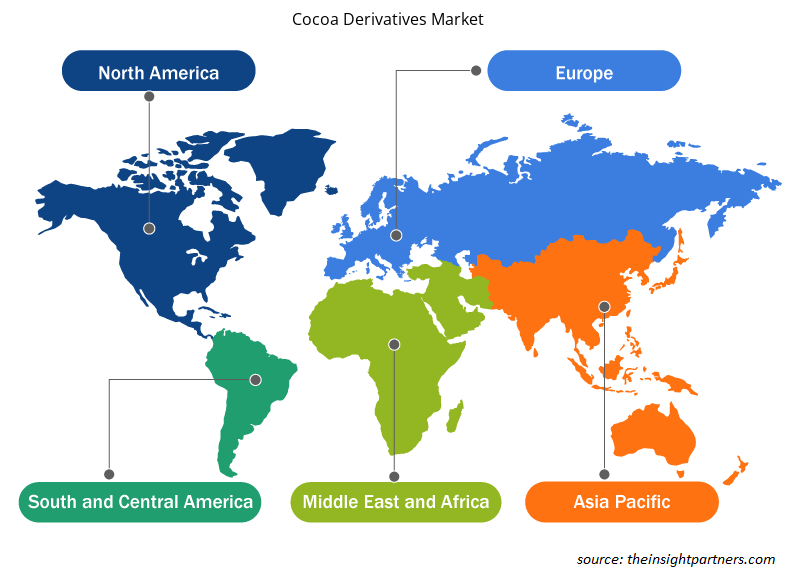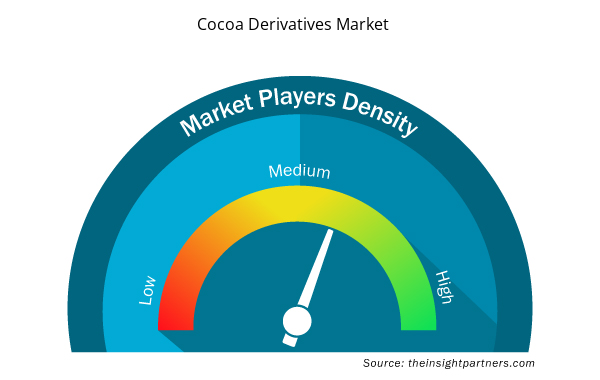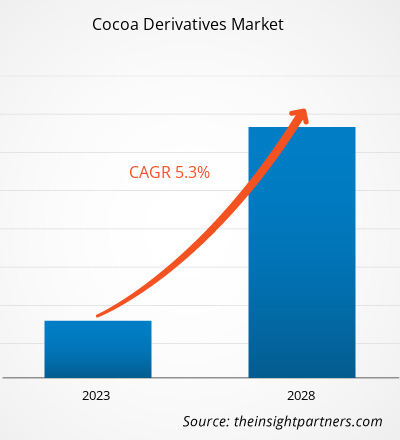可可衍生物市场规模预计将从 2022 年的 278.0713 亿美元增长到 2028 年的 377.9986 亿美元;预计2022 年至 2028 年的复合年增长率为 5.3%。
可可衍生物是通过加工可可而获得的可可产品。可可衍生物的类型包括可可豆、可可脂和可可粉。这些衍生物也有有机和常规类别。全球市场对有机和 公平贸易认证的可可豆的需求正在增长。消费者倾向于消费有助于他们保持整体健康的更安全的产品。人们对无农药食品的兴趣日益浓厚,对有机种植可可的需求产生了积极影响。根据有机农业研究所 ( FiBL ) 和国际有机农业运动联合会 ( IFOAM ) 的《2022 年有机农业世界报告》,2020 年全球有机可可的种植面积达到 3.1%。此外,Lindt & Sprüngli表示,他们在欧洲的有机可可产品销售增长速度远快于整体可可产品销售。因此,制造商正在将有机产品添加到他们的产品组合中以满足日益增长的需求。例如,百乐嘉利宝提供国产、有机认证、非碱化可可粉。
2022 年,欧洲占据可可衍生物市场的最大份额。预计在预测期内,亚太地区的市场将以最高的复合年增长率增长。该地区的市场增长归因于美食巧克力在欧洲人中越来越受欢迎。因此,不同的高端巧克力品牌一直在广泛寻找方法来区分他们的产品,同时专注于采购单一庄园产品。因此,该地区对高品质可可和单一产地可可口味的需求正在上升。例如,总部位于法国的世界最好的巧克力生产商Valrhona Inc. 一直在从 Maria Trinidad Sanchez 收获可可豆,这是一个单一产地的可可庄园。此外,消费者对健康生活的倾向引发了对优质可可衍生物的需求,如可可脂、可可粉和可可豆。
定制此报告以满足您的需求
您可以免费定制任何报告,包括本报告的部分内容、国家级分析、Excel 数据包,以及为初创企业和大学提供优惠和折扣
- 获取此报告的关键市场趋势。这个免费样品将包括数据分析,从市场趋势到估计和预测。
COVID-19 疫情对可可衍生品市场的影响
新冠疫情影响了各国的经济和行业。北美、欧洲、亚太地区 ( APAC )、南美和中美 ( SAM ) 以及中东和非洲 ( MEA ) 的封锁、旅行限制和企业关闭阻碍了多个行业的增长,包括食品和饮料行业。制造部门的关闭导致全球供应链、制造活动、交付计划以及必需品和非必需品销售中断。2020 年,各公司的产品交付延迟,产品销量下滑。此外,欧洲、亚太地区和北美各国政府对国际旅行实施的禁令迫使公司暂时停止合作和伙伴关系计划。所有这些因素在 2020 年和 2021 年初阻碍了各行业的发展,从而抑制了各市场的增长。
2020 年,社会经济形势的变化对高端产品的消费模式产生了负面影响。全球危机期间,世界多个国家的政府实施了限制措施,导致可可生产规模虽小但重要的可可生产国的农民遭受经济损失,因为在疫情爆发的最初几个月,产量超过了需求。这导致可可价格大幅下跌。根据纽约国际可可组织 ( ICCO ) 的数据,2021 年 1 月可可合约价格平均约为每吨 2,528 美元,比上年价格(每吨 2,675 美元)下降了 6%。此外,个人护理、食品和饮料行业设施的关闭影响了可可衍生品市场的表现。
2021 年,随着各国政府宣布放松先前实施的限制措施,多个经济体恢复运营,提振了全球市场。此外,制造商获准满负荷运营,这有助于他们克服供需缺口和其他影响。由于到 2021 年全球大多数人口已完全接种疫苗,可可衍生品制造商专注于扩大生产运营以重振业务。
市场洞察
主要参与者的战略发展有利于可可衍生品市场的增长
2020 年 9 月,Olam Group Ltd 推出了面向专业人士的 Olam Cocoa,将其优质的 deZaan 可可粉提供给餐厅、餐饮服务商和糕点店。该战略旨在满足专业厨师和面包师对高品质可可原料日益增长的需求。市场主要参与者的此类战略发展预计将在未来几年推动可可衍生品市场的增长。
类型洞察
根据类型,可可衍生物市场细分为可可豆、可可脂、可可粉等。可可豆部分在 2022 年占据最大市场份额,可可粉部分预计在预测期内将实现最高复合年增长率。可可粉是一种无糖粉末,通过压碎从可可树果实中提取的可可豆获得。压榨巧克力浆以去除可可脂,然后加工残留的可可固体以制成精细的无糖可可粉。消费者对更好的风味、颜色和质地的日益倾向推动了对可可粉的需求。
应用程序洞察
根据应用,可可衍生物市场细分为食品和饮料、个人护理和其他。可可衍生物广泛用于制作烘焙产品、饮料、糖果、乳制品和零食。然而,对清洁标签和纯素产品的新兴需求导致可可脂、可可粉、可可粒和可可液等植物成分的销售蓬勃发展。因此,食品和饮料行业对植物产品的需求不断增加,推动了可可衍生物市场的增长。Olam International 和 Cargill, Incorporated 是提供用于食品和饮料应用的可可衍生物的主要制造商。
Olam Group Ltd、Indcre SA、Cargill Inc、Natra SA、JB Foods Ltd、Ecuakao Group Ltd、United Cocoa Processor Inc、Barry Callebaut AG、Moner Cocoa SA 和 Altınmarka Gıda San ve Tic AS 是可可衍生品市场的主要参与者。这些公司主要专注于产品创新,以扩大市场规模并追随新兴趋势。
可可衍生品市场区域洞察
Insight Partners 的分析师已详细解释了预测期内影响可可衍生品市场的区域趋势和因素。本节还讨论了北美、欧洲、亚太地区、中东和非洲以及南美和中美洲的可可衍生品市场细分和地理位置。

- 获取可可衍生品市场的区域特定数据
可可衍生品市场报告范围
| 报告属性 | 细节 |
|---|---|
| 2022 年市场规模 | 278.1亿美元 |
| 2028 年市场规模 | 378亿美元 |
| 全球复合年增长率(2022 - 2028) | 5.3% |
| 史料 | 2020-2021 |
| 预测期 | 2023-2028 |
| 涵盖的领域 | 按类型
|
| 覆盖地区和国家 | 北美
|
| 市场领导者和主要公司简介 |
|
可可衍生品市场参与者密度:了解其对业务动态的影响
可可衍生品市场正在快速增长,这得益于终端用户需求的不断增长,而这些需求又源于消费者偏好的不断变化、技术进步以及对产品优势的认识不断提高等因素。随着需求的增加,企业正在扩大其产品范围,进行创新以满足消费者的需求,并利用新兴趋势,从而进一步推动市场增长。
市场参与者密度是指在特定市场或行业内运营的企业或公司的分布情况。它表明在给定市场空间中,相对于其规模或总市场价值,有多少竞争对手(市场参与者)存在。
在可可衍生品市场运营的主要公司有:
- 奥兰集团有限公司
- 印德克公司
- 嘉吉公司
- 纳特拉公司
- JB 食品有限公司
免责声明:上面列出的公司没有按照任何特定顺序排列。

- 获取可可衍生品市场顶级关键参与者的概述
报告亮点
- 可可衍生品市场的渐进式行业趋势,帮助企业制定有效的长期战略
- 发达国家和发展中国家市场参与者采用的业务增长战略
- 2022 年至 2028 年市场定量分析
- 全球可可衍生物需求量估计
- 波特五力分析说明可可衍生品市场中买家和供应商的效力
- 了解竞争市场状况的最新发展
- 可可衍生品市场的趋势和前景以及增长动力和限制因素
- 通过强调支撑商业利益的市场策略来协助决策过程
- 不同节点的可可衍生品市场规模
- 可可衍生物行业市场和增长动态的详细概述和细分
- 各地区可可衍生品市场规模及增长潜力
- 历史分析(2 年)、基准年、预测(7 年)及复合年增长率
- PEST 和 SWOT 分析
- 市场规模价值/数量 - 全球、区域、国家
- 行业和竞争格局
- Excel 数据集



Report Coverage
Revenue forecast, Company Analysis, Industry landscape, Growth factors, and Trends

Segment Covered
This text is related
to segments covered.

Regional Scope
North America, Europe, Asia Pacific, Middle East & Africa, South & Central America

Country Scope
This text is related
to country scope.
常见问题
The rising demand for cocoa-based confectioneries and the utilization of cocoa as a sustainable beauty ingredient by the cosmetic industry are some of the key driving factors for the cocoa derivatives market.
Based on application, personal care is the fastest-growing segment in the cocoa derivatives market due to its high antioxidant properties and its richness in flavanols.
Europe accounted for the largest share of the global cocoa derivatives market. The market growth is attributed to the increasing popularity of specialty chocolates among the European population which boost the demand for cocoa derivatives.
Based on the type, the cocoa beans segment accounted for the largest revenue share as it promotes healthy digestion due to their fibre content. The fibre content helps soften bowel movements, prevent haemorrhoids and help with other digestive conditions. it finds wide application in industries such as food & beverage, confectionery, and pharmaceuticals.
Increasing demand for organic and fairtrade cocoa derivatives is further expected to create lucrative opportunities for cocoa derivatives market growth.
The major players operating in the global cocoa derivatives market are Olam Group Ltd, Indcre SA, Cargill Inc, Natra SA, JB Foods Ltd , Ecuakao Group Ltd, United Cocoa Processor Inc, Barry Callebaut AG, Moner Cocoa SA, Altınmarka Gıda San ve Tic AS among few others.
Trends and growth analysis reports related to Food and Beverages : READ MORE..
The List of Companies - Cocoa Derivatives Market
- Olam Group Ltd
- Indcre SA
- Cargill Inc
- Natra SA
- JB Foods Ltd
- Ecuakao Group Ltd
- United Cocoa Processor Inc
- Barry Callebaut AG
- Moner Cocoa SA
- Alt?nmarka G?da San ve Tic AS
The Insight Partners performs research in 4 major stages: Data Collection & Secondary Research, Primary Research, Data Analysis and Data Triangulation & Final Review.
- Data Collection and Secondary Research:
As a market research and consulting firm operating from a decade, we have published and advised several client across the globe. First step for any study will start with an assessment of currently available data and insights from existing reports. Further, historical and current market information is collected from Investor Presentations, Annual Reports, SEC Filings, etc., and other information related to company’s performance and market positioning are gathered from Paid Databases (Factiva, Hoovers, and Reuters) and various other publications available in public domain.
Several associations trade associates, technical forums, institutes, societies and organization are accessed to gain technical as well as market related insights through their publications such as research papers, blogs and press releases related to the studies are referred to get cues about the market. Further, white papers, journals, magazines, and other news articles published in last 3 years are scrutinized and analyzed to understand the current market trends.
- Primary Research:
The primarily interview analysis comprise of data obtained from industry participants interview and answers to survey questions gathered by in-house primary team.
For primary research, interviews are conducted with industry experts/CEOs/Marketing Managers/VPs/Subject Matter Experts from both demand and supply side to get a 360-degree view of the market. The primary team conducts several interviews based on the complexity of the markets to understand the various market trends and dynamics which makes research more credible and precise.
A typical research interview fulfils the following functions:
- Provides first-hand information on the market size, market trends, growth trends, competitive landscape, and outlook
- Validates and strengthens in-house secondary research findings
- Develops the analysis team’s expertise and market understanding
Primary research involves email interactions and telephone interviews for each market, category, segment, and sub-segment across geographies. The participants who typically take part in such a process include, but are not limited to:
- Industry participants: VPs, business development managers, market intelligence managers and national sales managers
- Outside experts: Valuation experts, research analysts and key opinion leaders specializing in the electronics and semiconductor industry.
Below is the breakup of our primary respondents by company, designation, and region:

Once we receive the confirmation from primary research sources or primary respondents, we finalize the base year market estimation and forecast the data as per the macroeconomic and microeconomic factors assessed during data collection.
- Data Analysis:
Once data is validated through both secondary as well as primary respondents, we finalize the market estimations by hypothesis formulation and factor analysis at regional and country level.
- Macro-Economic Factor Analysis:
We analyse macroeconomic indicators such the gross domestic product (GDP), increase in the demand for goods and services across industries, technological advancement, regional economic growth, governmental policies, the influence of COVID-19, PEST analysis, and other aspects. This analysis aids in setting benchmarks for various nations/regions and approximating market splits. Additionally, the general trend of the aforementioned components aid in determining the market's development possibilities.
- Country Level Data:
Various factors that are especially aligned to the country are taken into account to determine the market size for a certain area and country, including the presence of vendors, such as headquarters and offices, the country's GDP, demand patterns, and industry growth. To comprehend the market dynamics for the nation, a number of growth variables, inhibitors, application areas, and current market trends are researched. The aforementioned elements aid in determining the country's overall market's growth potential.
- Company Profile:
The “Table of Contents” is formulated by listing and analyzing more than 25 - 30 companies operating in the market ecosystem across geographies. However, we profile only 10 companies as a standard practice in our syndicate reports. These 10 companies comprise leading, emerging, and regional players. Nonetheless, our analysis is not restricted to the 10 listed companies, we also analyze other companies present in the market to develop a holistic view and understand the prevailing trends. The “Company Profiles” section in the report covers key facts, business description, products & services, financial information, SWOT analysis, and key developments. The financial information presented is extracted from the annual reports and official documents of the publicly listed companies. Upon collecting the information for the sections of respective companies, we verify them via various primary sources and then compile the data in respective company profiles. The company level information helps us in deriving the base number as well as in forecasting the market size.
- Developing Base Number:
Aggregation of sales statistics (2020-2022) and macro-economic factor, and other secondary and primary research insights are utilized to arrive at base number and related market shares for 2022. The data gaps are identified in this step and relevant market data is analyzed, collected from paid primary interviews or databases. On finalizing the base year market size, forecasts are developed on the basis of macro-economic, industry and market growth factors and company level analysis.
- Data Triangulation and Final Review:
The market findings and base year market size calculations are validated from supply as well as demand side. Demand side validations are based on macro-economic factor analysis and benchmarks for respective regions and countries. In case of supply side validations, revenues of major companies are estimated (in case not available) based on industry benchmark, approximate number of employees, product portfolio, and primary interviews revenues are gathered. Further revenue from target product/service segment is assessed to avoid overshooting of market statistics. In case of heavy deviations between supply and demand side values, all thes steps are repeated to achieve synchronization.
We follow an iterative model, wherein we share our research findings with Subject Matter Experts (SME’s) and Key Opinion Leaders (KOLs) until consensus view of the market is not formulated – this model negates any drastic deviation in the opinions of experts. Only validated and universally acceptable research findings are quoted in our reports.
We have important check points that we use to validate our research findings – which we call – data triangulation, where we validate the information, we generate from secondary sources with primary interviews and then we re-validate with our internal data bases and Subject matter experts. This comprehensive model enables us to deliver high quality, reliable data in shortest possible time.


 获取此报告的免费样本
获取此报告的免费样本